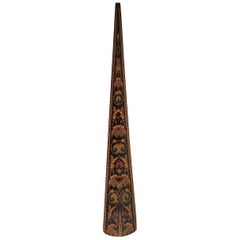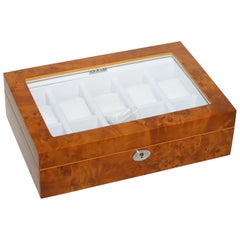Walnut Collectible Jewelry
2
to
1
1
2
2
2
1
2
38,076
1,527
595
542
301
2
1
1
1
Material: Walnut
Rare 19th Century English Tunbridgeware Hair Pin or Slide
Located in Dallas, TX
Presenting an absolutely gorgeous and extremely unique and rare 19th century British Tunbridgeware hair pin/bobbin or slide.
This slide is unlike any of it’s kind we have seen before…. it is a very rare survivor !
From circa 1860–1880.
Made of walnut with gorgeous marquetry inlay on the entirety of the front with classic Tunbridgeware micro-mosaic all over the front. The rear is walnut.
The marquetry inlay appears to be various different woods, namely, maple, walnut and satinwood.
Would have been worn in a Lady’s hair bun with the micro-mosaic facing forward.
This would have belonged to a very elegant lady in the mid to late 19th century.
Tunbridge ware is a form of decoratively inlaid woodwork, typically in the form of boxes, that is characteristic of Tonbridge and the spa town of Royal Tunbridge Wells in Kent in the 18th and 19th centuries. The decoration typically consists of a mosaic of many very small pieces of different coloured woods that form a pictorial vignette. Shaped rods and slivers of wood were first carefully glued together, then cut into many thin slices of identical pictorial veneer with a fine saw. Elaborately striped and feathered bandings for framing were pre-formed in a similar fashion.
There is a collection of Tunbridge ware in the Tunbridge Wells Museum and Art Gallery in Tunbridge Wells.
The famous makers of Tunbridge ware were in the Tunbridge Wells area of Kent; their most notable work was from circa 1830-1900.
Early makers of Tunbridge ware, in Tunbridge Wells in the mid-18th century, were the Burrows family, and Fenner and Co. In the 19th century, around 1830, James Burrows invented a technique of creating mosaics from wooden tesserae. Henry Hollamby, apprenticed to the Burrows family, set up on his own in 1842 and became an important manufacturer of Tunbridge ware, employing about 40 people.
Edmund Nye (1797–1863) and his father took over the Fenner company when William Fenner retired in 1840, after 30 years in partnership with him. Thomas Barton (1819–1903), previously apprenticed at the Wise factory, joined the Nyes in 1836, and worked as Nye’s designer; he took over the business in 1863 and continued there until his death.
In Tonbridge (near to Tunbridge Wells), George Wise (1703–1779) is known to have had a business in 1746. It continued with his son Thomas, and Thomas’s nephew George (1779–1869), who took over in 1806. In its early years the company made articles such as workboxes and tea caddies with prints of popular views; later items had pictures created from mosaics. Their workshop in Tonbridge, Wise’s Tunbridge Ware Manufactory, was next to the Big Bridge over the Medway; the building was demolished in 1886 to widen the approach to the bridge.
Tunbridge ware became popular with visitors to the spa town of Tunbridge Wells, who bought them as souvenirs and gifts. Articles included cribbage boards, paperweights, writing slopes, snuffboxes and glove boxes.
At the Great Exhibition of 1851, Tunbridge ware by Edmund Nye, Robert Russell and Henry Hollamby was shown; Edmund Nye received a commendation from the judges for his work. He exhibited a table depicting a mosaic of a ship at sea; 110,800 tesserae were used in making the picture.
The manufacturers of Tunbridge ware were cottage industries, and they were no more than nine in Tunbridge Wells and one in Tonbridge. The number declined in the 1880s; competent craftsmen were hard to find, and public tastes changed. After the death of Thomas Barton in 1903 the only surviving firm was Boyce, Brown and Kemp, which closed in 1927.
Marquetry was an old technique which was continued by Nye and Barton to create images such as birds or butterflies.
‘Green Oak’ as caused by the fungus Chlorociboria aeruginascens.
Stickware and half-square mosaic was invented by James Burrows in about 1830: a bunch of wooden sticks of different colours, each having triangular or diamond-shaped cross section, were tightly glued together; in the case of stickware, the resulting block was dried, then turned to form an article such as the base of a pincushion. For half-square mosaic, thin slices were taken from the composite block, and applied to a surface.[1][2][4]
Tesselated mosaic, was a development by James Burrows of half-square mosaic; it was adopted by George Wise and Edmund Nye. Minute tesserae were used to form a wide variety of geometric and pictorial designs.
Many sorts of wood were used for the various colours; about 40 were in regular use. Only natural colors were used; green was provided by “green oak”, produced by the action of fungus on fallen oak. Designs for articles were often taken from designs of Berlin wool work.
Category
Late 19th Century English High Victorian Antique Walnut Collectible Jewelry
Materials
Satinwood, Walnut
Louis-Philippe Period Walnut Box with Doucine and Marquetry, circa 1840
Located in Beuzevillette, FR
Beautiful jewelry box in walnut. The four sides in doucine are decorated with a marquetry border, the top is decorated with a diamond also in m...
Category
1840s French Louis Philippe Antique Walnut Collectible Jewelry
Materials
Walnut
Related Items
American Walnut Satinwood Inlaid Valuables Box with Original Feet, Circa 1780
Located in Hollywood, SC
American Chippendale walnut oval satinwood inlaid valuables box with a carved molded hinged lid revealing an interior till with a secret hidden drawer, e...
Category
1780s American Chippendale Antique Walnut Collectible Jewelry
Materials
Satinwood, Walnut
H 6 in W 15.75 in D 7.5 in
Thorens Swiss AD 30 Upright Music Box with Ten Discs, circa 1970
Located in Evergreen, CO
A quality fruitwood case with a glass door allows for viewing the metal discs that play on this upright music box by Thorens of Switzerland. The set ...
Category
1970s Swiss Vintage Walnut Collectible Jewelry
Materials
Fruitwood
Classic Burl Walnut with Inlaid Brass Swiss Music Box
Located in Lambertville, NJ
This beautiful burl walnut music box with elegant brass inlaid top plays four different tunes. The rich sound resonated richly and has the workings made in Switzerland. The on and of...
Category
20th Century Swiss Walnut Collectible Jewelry
Materials
Brass
19th Century Gilt and Painted Cast Iron English Victorian Royal Coat of Arms
Located in Stamford, CT
Finely cast armorial of the Royal Coat of Arms after Queen Victoria ascended to the thrown, cold painted with gilt and silver gilding. Very fine detailing showing the gold lion and s...
Category
Late 19th Century High Victorian Antique Walnut Collectible Jewelry
Materials
Iron
H 9.5 in W 9 in D 0.25 in
Antique Jewelry Box Art Deco Period
Located in New York, NY
A beautiful antique Art Deco period jewelry box, styled by Jacques Kreisler, circa early-20th Century, New York, New York. Box is an aubergine ...
Category
Early 20th Century Art Deco Walnut Collectible Jewelry
Materials
Metal
19th Century Portrait Miniature of a Young Man with Curly Red Hair
Located in San Francisco, CA
19th century fine portrait miniature of a young man with curly red hair
Dimensions 3" x 2.5". The velvet lined mat measures 3.75" x 5".
The portrait is in very good condition. ...
Category
Late 19th Century British Late Victorian Antique Walnut Collectible Jewelry
Materials
Paper
Late 19th Century English Game Box
Located in Casteren, Noord-Brabant
Lovely antique game box, made of mahogany.
The box contains several games, with many bits and pieces. Not all complete.
It is obviously that there h...
Category
1890s British Belle Époque Antique Walnut Collectible Jewelry
Materials
Wood
19th Century Tortoise Shell Decorative Hair Comb or Head Piece
Located in Brooklyn, NY
A stunning and large antique 19th century tortoise shell, celluloid, or Bakelite hair comb or head piece with an intricate carved floral and open scroll ...
Category
Mid-19th Century Antique Walnut Collectible Jewelry
Materials
Plastic
Late 19th Century English Diorama Clipper Ship Shadowbox
Located in New York, NY
Late 19th century English Victorian painted diorama wall plaque of clipper ship with red flag painted in cloudy sky in mahogany frame.
Category
Late 19th Century British Victorian Antique Walnut Collectible Jewelry
Materials
Mahogany
English or French Antique Brass Surveyor's Transit Theodolite, last quarter 19th
Located in Atlanta, GA
From Wikipedia:
“A THEODOLITE is a precision optical instrument for measuring angles between designated visible points in the horizontal and vertical planes. The traditional use has been for land...
Category
1880s English Victorian Antique Walnut Collectible Jewelry
Materials
Brass
Rare Circa 1920’s Woman’s Rolex Watch Box Presentation Case
By Rolex
Located in Hamilton, Ontario
This vintage 1920’s intricate designed pressboard watch box is in excellent condition and is made with meticulous craftsmanship. Beautifully embossed top, reminiscent of tooled leath...
Category
1920s Swiss Vintage Walnut Collectible Jewelry
Materials
Leather, Wood
Antique 19th Century Victorian German Porcelain China Head Doll Molded Hair
Located in Dayton, OH
Antique mid 19th century German china doll with painted porcelain bust, feet and hands, cloth body and green dress. Measures: 18”.
Category
Mid-19th Century Victorian Antique Walnut Collectible Jewelry
Materials
Porcelain, Fabric, Paint
Previously Available Items
Burr Walnut Watch Display Case with Lock and Keys Exhibition Case
Located in GB
We are delighted to offer for sale this brand new burr walnut watch display case
This was a very generous unwanted gift, all my watches are in th...
Category
20th Century English Post-Modern Walnut Collectible Jewelry
Materials
Walnut
Recently Viewed
View AllMore Ways To Browse
Gold Coller Necklaces
Giraffe Link Bracelet
Lapponia Cufflinks
Ladies Diamond Wedding Set
Hobe Filigree
Grandma Jewelry
G Town Jewelers New York
Creeper Earrings
Double Strand Pearl Necklace With Diamond Clasp
Destino Cufflinks
Corum For Cartier
Star Saphire
Star Saphire Rings
Suomen Kultasepp� Oy On Sale
Omega Speedsonic
Swatch X Omega
Tag Autavia Chrono
Tag Heuer Watches Under 500



